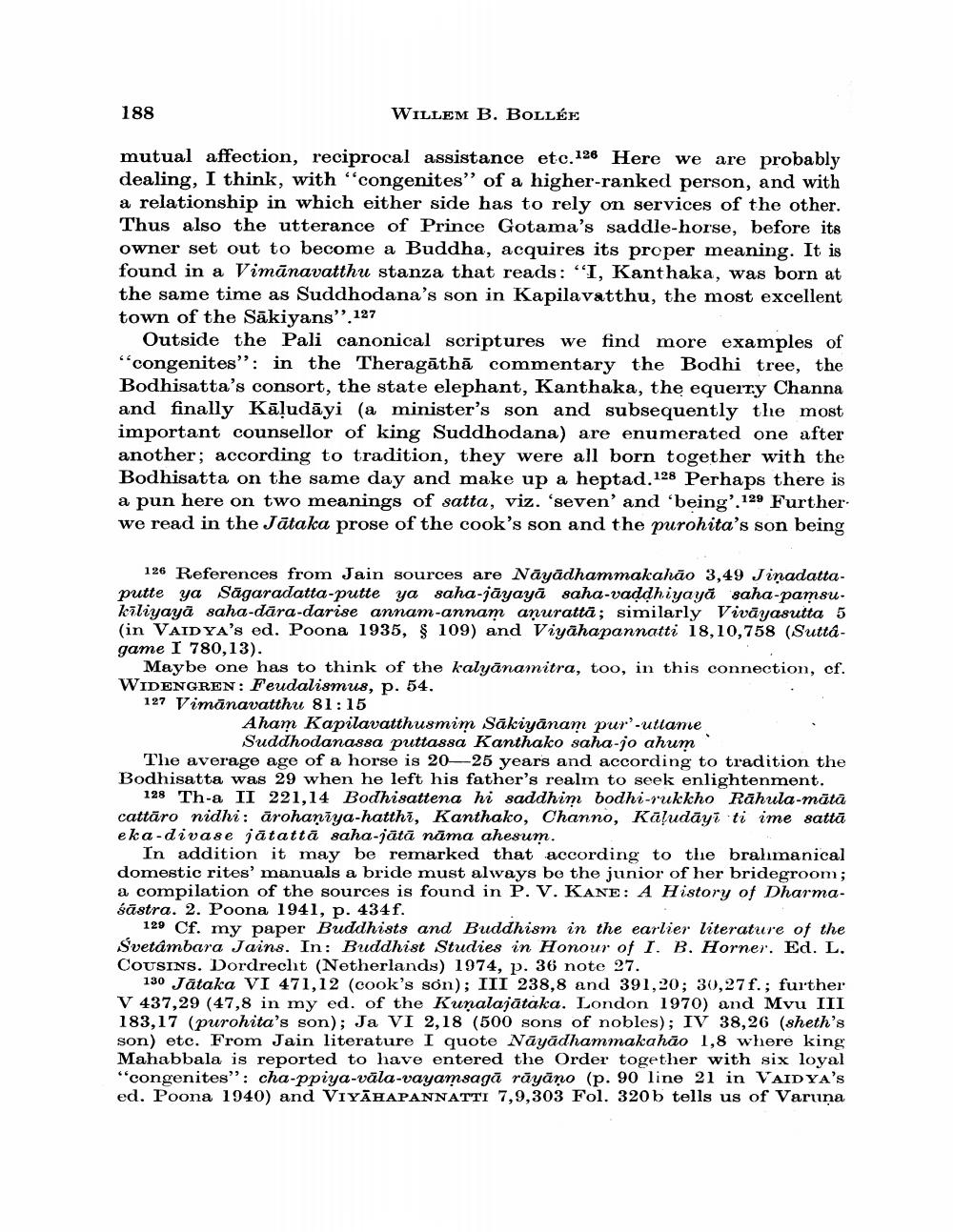________________
188
WILLEM B. BOLLÉE
mutual affection, reciprocal assistance etc.126 Here we are probably dealing, I think, with “congenites” of a higher-ranked person, and with a relationship in which either side has to rely on services of the other. Thus also the utterance of Prince Gotama's saddle-horse, before its owner set out to become a Buddha, acquires its proper meaning. It is found in a Vimānavatthu stanza that reads: "I, Kanthaka, was born at the same time as Suddhodana's son in Kapilavatthu, the most excellent town of the Sākiyans" 127
Outside the Pali canonical scriptures we find more examples of "congenites": in the Theragāthā commentary the Bodhi tree, the Bodhisatta's consort, the state elephant, Kanthaka, the equerry Channa and finally Kāludāyi (a minister's son and subsequently the most important counsellor of king Suddhodana) are enumerated one after another; according to tradition, they were all born together with the Bodhisatta on the same day and make up a heptad. 128 Perhaps there is a pun here on two meanings of satta, viz. 'seven' and 'being'.129 Further we read in the Jātaka prose of the cook's son and the purohita's son being
126 References from Jain sources are Näyädhammakahão 3,49 Jinadattaputte ya Sāgaradatta-putte ya saha-jāyayā saha-vaddhiyaya saha-pamsu. kaliyaya saha-dara-darise annam-annam anuratta; similarly Vivāyasutta 5 (in VAID YA's ed. Poona 1935, $ 109) and Viyahapannatti 18,10,758 (Suttagame I 780,13).
Maybe one has to think of the kalyānamitra, too, in this connection, cf. WIDENGREN: Feudalismus, p. 54. 127 Vimānavatthu 81:15
Aham Kapilavatthusmim Sākiyānam pur'-utlame
Suddhodanassa puttassa Kanthako saha-jo ahum The average age of a horse is 20—25 years and according to tradition the Bodhisatta was 29 when he left his father's realm to seek enlightenment.
128 Th-a II 221,14 Bodhisattena hi saddhim bodhi-rukkho Rahula-mātā cattāro nidhi: arohaniya-hatthi, Kanthako, Channo, Kaļudāyi ti ime sattā e ka divase jätattā saha-jātā nāma ahesum.
In addition it may be remarked that according to the brahmanical domestic rites' manuals a bride must always be the junior of her bridegroom; a compilation of the sources is found in P. V. KANE: A History of Dharmaśāstra. 2. Poona 1941, p. 434f.
129 Cf. my paper Buddhists and Buddhism in the earlier literature of the Svetambara Jains. In: Buddhist Studies in Honour of I. B. Horner. Ed. L. COUSINS. Dordrecht (Netherlands) 1974, p. 36 note 27.
130 Jātaka VI 471,12 (cook's son); III 238,8 and 391,20; 30,27f.; further V 437,29 (47,8 in my ed. of the Kunalajātaka. London 1970) and Mvu III 183,17 (purohita's son); Ja VI 2,18 (500 sons of nobles); IV 38,26 (sheth's son) etc. From Jain literature I quote Nāyādhammakahāo 1,8 where king Mahabbala is reported to have entered the Order together with six loyal "congenites": cha-ppiya-vāla-vayamsagā rāyāno (p. 90 line 21 in VAIDYA's ed. Poona 1940) and VIYĀHAPANNATTI 7,9,303 Fol. 320b tells us of Varuna




